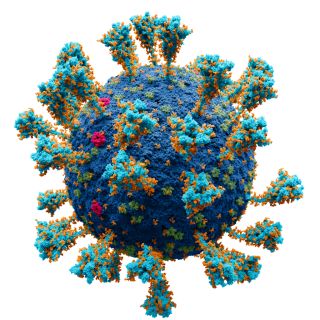Coronavirus Disease 2019
Why Do Some People Hesitate to Be Vaccinated?
Here’s how vaccine conspiracy theories follow coincidences.
Posted October 6, 2023 Reviewed by Davia Sills
Key points
- For those who hesitate to be vaccinated, there is worry about the virus coming around the world this fall.
- Hidden variables are tricky. With them, people can miss the connection between cause and effect.
- COVID-19 carries a small possibility of organ failure or heart inflammation.
- Gatherings of a few people indoors have small odds of spreading COVID-19. As numbers grow, so does risk.

If you search through just two or three original sources of research material on COVID-19 to understand the pandemic that is now endemic, your head will swell from endless scientific detail often brought out in meaningful yet unintelligible terminology. I spend most of my weekday mornings filtering consequences from heaps of expertly intelligible verbiage to bring meaning to my general readership. It is a deciphering exercise. I write about pandemics. (See: “The Partiality of Risk in a Pandemic,” “The Thing We Call SARS-CoV-2 Is Not Alive,” and “The Pandemic Clock Mirage.")
Sometimes, not often, my siftings—even those coming from some of the world’s most respected journals—red-flag basic innate logic.
Why do I write about the pandemic? I am not an epidemiologist. By training, I am a mathematician and science writer involved in risk analysis who sees the risk of contracting a transmissible disease as a matter of space, numbers, and coincidences involving critical timing. I see the odds of contracting the virus as low if one is for a short time near a few people who are unaware of their infection positivity. As the number of people and time of mingling grows, however, so does the likelihood of contracting the virus.
With the latest surge in COVID-19 comes the latest sweep of conspiracy theories that are purposely built from coincidence stories. One that continues to emerge is that since so many people are unmasked in public indoors and are not affected by the virus, there is nothing to worry about. That may be true for small numbers of mingling people.
Unfortunately, some people follow social media’s partially true myths that the vaccine will have an out-of-pocket cost. That might happen for anyone who does not have health insurance; however, most states in the U.S. now pick up the costs for people who do not have insurance coverage.
There is a lingering notion driven by social media that COVID-19 symptoms are not so bad, and they “offer some immunity anyway.” Sure, people who have had COVID-19 do not need to be vaccinated in the short time since recovering. They have some lingering immunities against infection. However, before long, like a battery’s shelf life, immunities diminish to giving almost no protection. The risk of complications goes up with waning protection.
In early 2020, epidemiologists knew a great deal about pandemics in general but not much about the virus SARS-CoV-2. They now know much more. For example, experts know about COVID-19 infection complications involving organ failures and cardiovascular problems associated with arrhythmias, heart inflammation, thromboembolism, and liver injury. Those are long-term problems affecting between 20 and 30 percent of those who contract COVID-19. Moreover, there are indications of neurological effects causing altered mental acuity, and for pregnant women with COVID-19, fetal growth restrictions can complicate births. Most people do not know about any of these complications because there are so many false scenarios that confuse the public.
Challenge the bigger issue: false beliefs.
Statistics can show conceivable evidence but cannot prove that one thing causes another. Hidden variables can tell us a great deal about the truth if they can be exposed. Coincidences mistakenly used as causes unintentionally contribute to vaccine hesitancy. For those who, under the reins of false information, hesitate to be vaccinated, there is worry about the virus coming around the world this fall.
Truth often lies within the careful and intelligent data collection. Correlations between cause and effect are sometimes discovered by exposing variables that were once hidden in the research. However, confounding circumstances often make us believe that statistical correlation implies a cause. Causes are revealed only through logic. A could appear to cause B by causing C, which just happens to cause B.
Sometimes, A causes B for no apparent reason at all. I give the example of a powder extracted from the bark of a willow tree known to relieve headaches and fevers as far back as the 15th century. We know it as aspirin, but in 1899, when the Bayer Corporation produced the extract in pill form, statisticians were able to demonstrate that ingesting the pill (A) effectively relieved headaches and fevers (B). But nobody knew why.
That powder, extracted from the bark of a willow tree, has been known since the 15th century to be a medication that eases headaches and relieves fevers. Then, just 50 years ago, the British pharmacologist John Robert Vane showed that aspirin suppressed the production of certain molecular compounds that regulate the contraction and relaxation of muscle tissue. Finally, and decisively, we had a cause.
Coincidences insinuate causes contributing to vaccine hesitancy.
Humans tend to make connections where there are none; they manage to ignore correlations that are too complex to predict. They see coincidences as events mysteriously fated by some deeply significant design. That might be true, and it might not be. But whenever we genuinely have a reason for something, it almost always turns out that there is no single explanation. I say this because, too often, a coincidental correlation can influence bad judgments of cause and effect. We have the unfortunate example of an expert clinging to the false claim that vaccines can cause autism and sudden infant death syndrome (SIDS). Like the aspirin powder, no one knows the reason for autism or SIDS.
When two variables appear to have a statistical connection, either by chance or through hidden variables, a mistaken belief in a false linkage is encouraged. Many of these beliefs come from coincidental connections. Inevitably, some people who start estrogen therapy will soon have a stroke. Others will have blood clots. With millions of vaccinations happening every hour, it should not be surprising to find that some people are experiencing epileptic seizures, allergies, type 1 diabetes, hepatitis C, and even HIV. But were they caused by the vaccine, or were they merely coincidences?
We now, luckily, have approved mRNA vaccines designed to protect us against COVID-19’s newest variants, BA.2.86 and XBB.1.5. Hurray! I got mine.
References
For 521 citations, check out: https://en.wikipedia.org/wiki/COVID-19
Joseph Mazur, Fluke: The Math and Myth of Coincidences (New York: Basic Books, 2016) 127-28.




